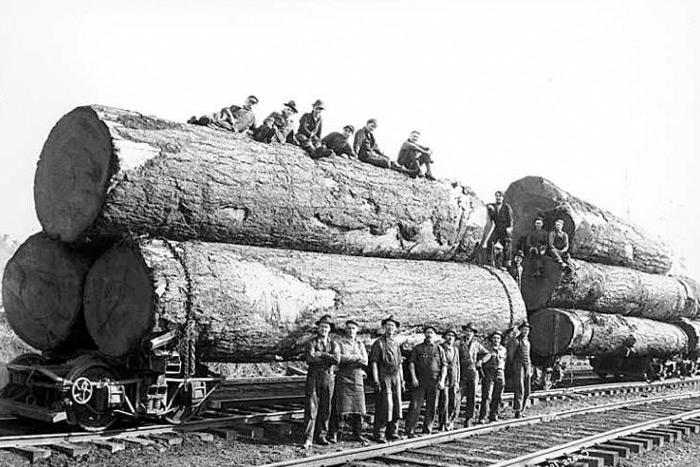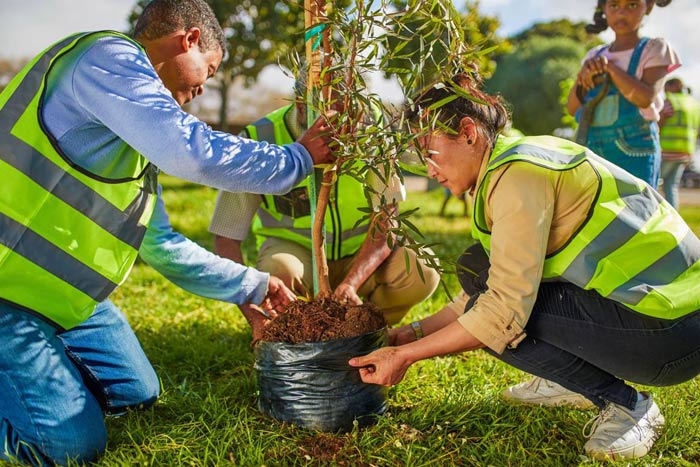In light of global challenges like climate change and deforestation, the significance of trees has grown.
Trees enhance air quality by filtering pollutants and releasing oxygen. They also play a vital role in water absorption, helping to prevent disasters like floods and landslides.
Thanks to advances in satellite imagery, we now have a more accurate estimate of the global tree population. There are estimated to be 3.04 trillion trees1 worldwide, according to a study in journal Nature, which is 8 times more than previous estimates suggested 10 years ago.
This means that there are roughly 422 trees for every person on earth. Interestingly, there were only about 70 million trees in the US about 100 years ago.
With our current rate of deforestation and at the same time a large number of tree-planting initiatives, that number is expected to stabilize over the coming decades.

What we cover
ToggleCountries With The Most Trees
While a whopping 3 trillion trees give you something less to worry about, their distribution around the world is the biggest issue.
Nearly 50% of the world’s forests2 are found in the 5 biggest countries; Russia, Canada, Brazil, the USA, and China, while almost two-thirds of this stems from ten countries, including; The Democratic Republic of Congo, Indonesia, Australia, Peru, and India.
The table below shows the tree distribution among the top ten countries.
| Country | Total No. of Trees |
|---|---|
| Russia | 642 Billion |
| Canada | 318 Billion |
| Brazil | 302 Billion |
| USA | 228 Billion |
| China | 140 Billion |
| Democratic Republic of Congo | 101 Billion |
| Indonesia | 81 Billion |
| Australia | 77 Billion |
| Rest of the World | 1990 Billion |
Even though there are about 3 trillion trees in the world, it doesn’t mean they are evenly distributed.
- Russia – takes the top spot in terms of having the most trees in the world. Russia has earned the distinction of “Land of the Most Trees!” with over 642 billion trees.
- Canada – takes second place with over 318 billion trees covering around 40% of the country’s land. As a result, Canada’s forests represent 30% of the entire world’s forests. The most common trees in Canada are spruce trees, distinguished by their needle-like leaves.
- China – has over 140 billion trees, which accounts for around 23% of the country’s surface area. Over the years, the Chinese government has planted more than 66 billion trees.
- Brazil – is home to the Amazon, the world’s biggest forest. There are over 302 billion trees in the country, but they are in jeopardy because of the high rate of deforestation.
- United States – is home to the world’s oldest trees. Among the country’s 228 billion trees, the exceptional is the 5000-year-old “Great Bristlecone Pine” in California’s White Mountains, the World’s Oldest Tree.

This data shows that the larger the land size, the more likely a country will have more trees.
Countries With the Best Tree Density
Besides the tree total numbers, we can also measure the ‘tree wealth’ of countries using their tree density. Tree density refers to the number of trees per square kilometer of the country’s total area.
Even though some countries have more trees than others, that does not necessarily mean they have the best tree density.
Finland, Sweden, Slovenia, Bolivia, Equatorial Guinea, French Guiana, and Taiwan take the lead. On the other hand, desert countries such as Qatar, the United Arab Emirates, and Greenland have almost zero tree cover.
Finland ranks first with over 72,644 trees per square kilometer. Finnish forests are also denser than most forests worldwide, according to studies. Finland is one of the most forested European countries because trees cover 70%.
Moreover, Finland plants 150 million trees yearly, so the numbers will continue to increase as the years go by.
On the other hand, trees cover 60% of the land area in Slovenia, with over 71,131 trees per square kilometer.
| Country | Trees per sq kilometer |
|---|---|
| Finland | 72,644 |
| Sweden | 69,161 |
| Slovenia | 71,131 |
| Taiwan | 62,975 |
| French Guiana | 60,326 |
| Equatorial Guinea | 61,791 |

How Many Trees Per Person in The World?
Another way to estimate ‘tree wealth’ is through the number of trees relative to the population. With the world’s average at 422 trees per person, countries with the best tree-per-person ratio include Canada, Russia, Gabon, Bolivia, Guyana, and the Central African Republic.
Desert countries still indicate a lower tree wealth, with countries like Egypt indicating only 1 tree per person.
This metric model proved to be sensitive to the population of the countries. For instance, a country like India with slightly over a Billion people and around 36 billion trees recorded around 30 trees per person.
On the other hand, smaller countries like Guyana and French Guiana, with less than a million people, record about 20,000 trees per person.
| Country | Trees per Person |
|---|---|
| Canada | 8,953 |
| Russia | 4,461 |
| Gabon | 8,131 |
| Bolivia | 5,465 |
| Guyana | 14,692 |
| Central African Republic | 5,152 |
| French Guiana | 20,226 |
How Many Trees Were There Before Humans?
There were an estimated 6 trillion trees, or roughly double the number today. Before the dawn of man and civilization, most historians estimate that the world’s forests took up around 6 billion hectares of land. Today, only a fraction of that remains, with the forest cover in the world down to approximately 3.1 billion hectares.
This loss can be attributed to intensive agricultural practices and modern civilization infrastructure. Annually the world loses nearly 15 billion trees each year.
How Many Trees Were There 100 Years Ago?

About 70 million trees. The early 1920s defined an exponential growth in the timber industry due to the developments that were happening in the construction and recreation industry. This made it one of the key drivers of deforestation in the US.
With no realistic forest management laws and programs in place, the country (especially the East Coast) experienced a massive forest cover loss.
It’s estimated that nearly two-thirds of the American forests were logged without replacement during this period.
Note: More articles on the number of trees being planted each year, deforestation stats, and urban tree removal on the homepage.
How Many Trees Will There be in 2050?
Based on a study by the Center for Global Development, the world is set to lose more than a million square miles to deforestation by 2050 if we keep walking on the same environmental path.
Moreover, with the population of many major cities projected to increase, the demand for more land, agriculture, and forest products may increase deforestation, especially in middle-economy countries.
By 2050, some small and middle economic countries may have less than 1% of forest cover.
In terms of numbers, the world total may fall to around 2 trillion trees – which may seem adequate, but it’s a big reason to worry for future generations.
On the brighter side, the total number of trees can also increase by 2050, with the right policies in place.
As of 2020, the rate of deforestation3 has drastically fallen in most countries thanks to the numerous policies in place. There has also been a huge global tree awareness campaign, e.g., The Trillion Trees Vision and the 60 Billion Trees Campaign by 2050, in the US.
If these campaigns are successful, and governments continue to tighten their deforestation rules, the world might actually see an increase in the total number of trees in 2050.
Are we Running Out of Trees?

Not really. Even though the world loses around 10 billion trees each year, more countries have adopted tree replanting initiatives that ensure the survival of trees for years to come.
Now more than ever, more people and companies are planting more trees than they are harvesting.
Given that countries like the United States have experienced an increased number of trees compared to 100 years ago, we might have more trees than we’ve had over the last few centuries.
Nevertheless, this doesn’t mean it’s impossible to run out of trees. Some studies still indicate that the world is losing trees faster than ever. As the demand for timber skyrockets, we might run out of trees within three centuries unless we don’t uphold strict deforestation rules.
How Many Trees Were Planted in 2019?

About 7 billion trees. Planting trees to help alleviate the impacts of climate change was pretty much the theme for 2019. Thousands of organizations, events, and causes sought to help plant as many trees as possible.
In the US alone, more than 5 million trees we planted over the year across 18,000 acres of the National Forests.
Countries like Ethiopia almost made a Guinness World Record with their 4 billion tree planting initiative when they tried to plant 200 million trees in a day. In slightly over 12 hours, the country reported planting 353,633,660 trees – which was 100m trees more than their target.
In the UK, the government reported planting over 3,281,000 trees across a 1,956-hectare piece of land. For Brazil, more than 4.7 million trees were planted to help recover the forest cover lost from fires.
Turkey also famously planted around 11 million trees in late 2019.
With most countries setting tree planting initiative goals for 2030 and 2050, we can expect even more trees to be planted in 2020 and the subsequent years.
FAQ's
The more trees we can plant, the better we’ll stand against global warming. A trillion trees would play a key role in cleaning up our atmosphere by sucking out over 750 billion metric tons of heat-trapping carbon dioxide.
There are four countries that survive without trees: Qatar, Greenland, the Faroe Islands, and Haiti. You may, however, find the occasional shrubs and some grass in these environments.
Approximately 300 years if we don’t turn things around. However, it’s highly unlikely that the earth will run out of trees on earth as the tables are turning with the number of trees being planted vs. the number of trees being cut down.
No, we cannot live without trees. Trees are essential for humans to exist. According to a study by the Center for Global Development, if we don’t change our environmental policy, the world is expected to lose over a million square miles of forest to deforestation by 2050.
The good news is that, as of 2020, there has been a drop in the rate of deforestation in most countries. This is largely due to the numerous policies implemented during the past decade. Undoubtedly, trees are important to the air we breathe, biodiversity, and life itself. A world without trees is not a sustainable one.
- Ehrenberg, R, (2015) Global forest survey finds trillions of trees. <https://www.nature.com/articles/nature.2015.18287> Accessed: 08-02-2024
- FAO, (2020) Global Forest Resources Assessment 2020. <http://www.fao.org/forest-resources-assessment/past-assessments/fra-2020/en/> Accessed: 08-02-2024
- World Economic Forum, (2018) Planet Earth has more trees now than 35 years ago. <https://www.weforum.org/stories/2018/08/planet-earth-has-more-trees-than-it-did-35-years-ago/> Accessed: 08-02-2024




